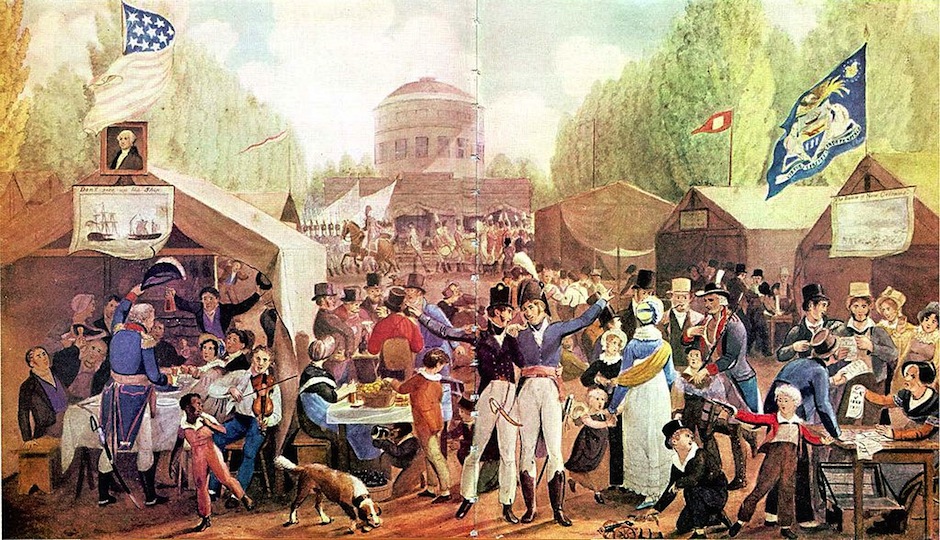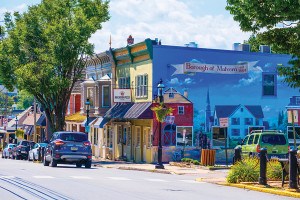Recommended: “The Lion and the Leopard” by Nathaniel Popkin

“Independence Day Celebration in Centre Square, Philadelphia” by John Lewis Krimmel, a central figure in Popkin’s book.
Nathaniel Popkin’s Philadelphia-set historical novel, The Lion and the Leopard, is a curious book. While it’s not an epistolary novel, it reads a bit like one, with separate sections narrated by different characters, each section headed by date and place. Some of the characters recur, like the famed American artist Charles Willson Peale. Others — most notably, Peale’s pet monkey — do not. Also included: a prostitute who seduces an accomplished painter; a woman who sells fruit at a street stall; Peale’s sons; and an artist who dies just as his career is taking off. There is also a writer, Caleb Cloud — the closest we get to a protagonist — through whose narration much of the book’s action is related.
That action takes place in the Philadelphia of the early 1800s, when the art establishment thrived at the Pennsylvania Academy of the Fine Arts (PAFA) and the city was flush with portraitists. Charles Willson Peale was the éminence grise of that scene, and his rather prickly persona–including a hefty dose of judgement directed at his sons–provides the novel with some of its fire. Peale’s sons, Raphaelle and Rembrandt, both struggle to define themselves outside of their father’s long shadow, but Raphaelle drinks and Rembrandt is tortured by his artistic mediocrity. Elsewhere, the devout Quaker Edward Hicks struggles to suppress his artistic urges but is unable to do so.
All of this would be interesting enough, but what moves the book forward is the journey taken by Caleb, Dixcy and Victor, three friends from Easton, Pa., who decide to try their luck in the big city. The three men represent a pattern of migration from that time, and Caleb’s breezy narrative swings along as casually as the trio’s rambling walk to Philadelphia.
Along the way they meet John Lewis Krimmel, an artist of singular talent and vision whose point of view will challenge Peale’s dominance and send ripples of rebellion through the Philadelphia art scene. In real life, Krimmel died young and remains underappreciated as a genre painter, so it’s admirable that Popkin chose Krimmel as the fulcrum around whom so much of the plot revolves. (Keats gets plenty of play in the book, and you can’t help noting the parallel — and the divergence: two artists who died young, one now celebrated and canonized, the other obscure and unknown outside of artistic circles.)
The book might sound rather heady, and it is. But for those interested in Philadelphia history, it’s also a lot of fun. There’s much detail about Philadelphia in the early 19th century, from street life and tavern culture to bookstores and observations like this one:
One thing you can say about Philadelphians, no matter the brightly colored parasols or the gilded vis-à-vis or the handfuls of private little societies (in Dr. Franklin’s Philadelphia it was said there was a club for every seven citizens and a separate religious denomination for every two): they like to talk, preferably in the middle of the street, and certainly in high voice (and sometimes with fists). And I don’t mean the bruyante cris of the street peddlers, but the penchant — in the Quaker City, no less — for revealing what’s on one’s mind. Oh, this tedious place! Everyone has an opinion.
Popkin is a longtime resident of Philadelphia. You can’t help but think he’s having a little fun here.
Also fun: The book is an artistic name-dropping delight. Historical figures in addition to Charles Wilson Peale and Krimmel who come to life through first-person narrated sections include Charles Bird King, Joseph Bonaparte, Raphaelle Peale, and Rembrandt Peale.
All these artists and art world figures have works on display at PAFA, which makes it the perfect venue for tonight’s Lion and Leopard book launch. Get there early for a special event: Popkin’s gallery tour of the paintings featured in the book.
Currently co-editor of Hidden City Daily, Popkin is also senior writer of the documentary series “Philadelphia: The Great Experiment” is the author of Song of the City: An Intimate History of the American Urban Landscape and The Possible City. In other words, he knows his stuff. Tonight’s launch party should be edifying for everyone, but especially delightful for Philly history junkies, city boosters, and art lovers.
Register here.


